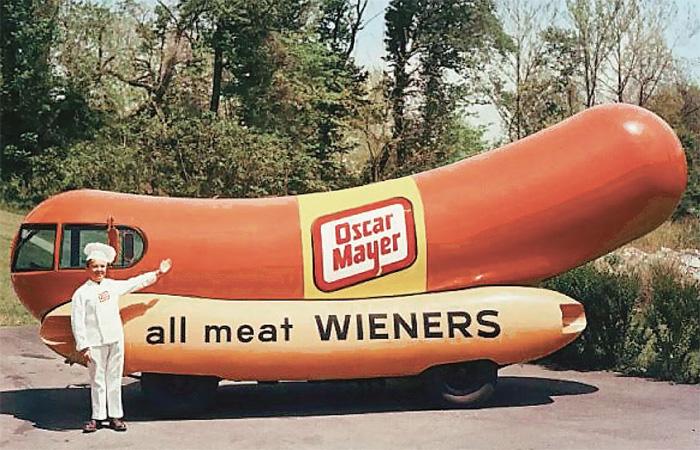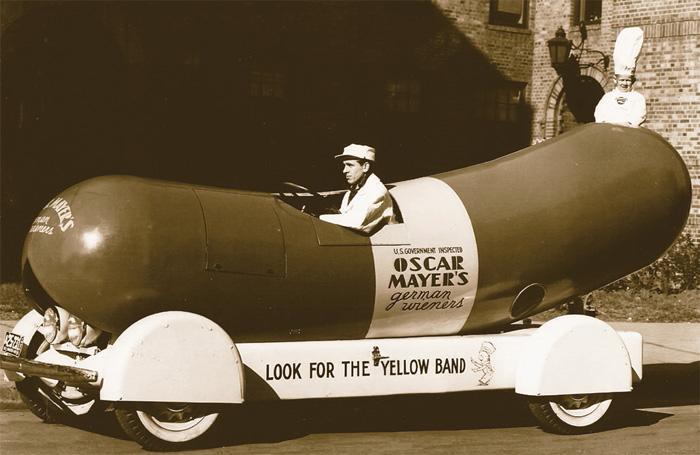
What’s Better Than a Wiener on Wheels?
 |
How many marketing stunts still drive people wild 80-plus years after the fact? Say, when’s the last time you heard about the Doublemint Twins? Yet the Oscar Mayer Wienermobile, which debuted three years before those Wrigley gum-chewing sisters, still cruises the country, as chronicled by the Eichler Network's Carol Sveilich in ‘Hot Dog Express’ in the new, summer ‘22 issue of CA-Modern magazine.
“In mid-century America, and certainly in our Eichler neighborhood in San Jose, hot dogs were a staple, a treat, a vital part of the all-American landscape,” Carol writes. “And what was more American than an Oscar Mayer wiener?”
“Oscar Mayer’s first Wienermobile hit the road in 1936, and today six distinctive models still roam across the country. They crisscross the states, equipped with an audio system blasting the wiener jingle in 21 different musical styles. It’s a true piece of Americana,” Carol writes.
The 1920s and 1930s were a high point for what architectural historians call 'programatic architecture' -- a Long Island duck farm stand shaped like a duck, for example, or an orange stand shaped like, well, you know. Or the Brown Derby hat-shaped restaurant in Los Angeles.
 |
These buildings are at the heart of 'roadside architecture,' designed to catch people’s eyes as they motor quickly by.
Well, the Wienermobile was something else, more 'on the road' architecture, and quite innovative. Some intensive historic research lasting, oh, about five minutes (the methodology? A DuckDuckGo search for 'vehicles shaped like food') doesn’t up come with anything that precedes the Wienermobile.
And much of what is revealed are one-offs. A banana car. A corn cob car. A crawfish.
It helped the Oscar Mayer company's cause that it was multimedia in its approach to selling hot dogs. Don’t forget – How can you forget? Not even if you try! – the Oscar Mayer jingle.
As Carol recalls: “In 1963, the Oscar Mayer wiener jingle made its radio debut, and the song became such a hit, folks were calling into radio stations to request it. There wasn’t a kid on our block who didn’t know the tune by heart.”
‘Hot Dog Express’ reveals much about the Oscar Mayer story, and about America in the mid-20th century as well. She notes, “Hot dogs equaled excitement and good health, at least to families in the 1950s and ‘60s.”
 |
Hmm.
“Like baked-goods producer Duncan Hines, Oscar Mayer was a real person,” Carol writes. “Oscar Ferdinand Mayer was born in Bavaria in 1859, and emigrated to the U.S. when he was 14. For the next two decades, based in Chicago, he produced a popular line of German-style meats. Then, in 1904, he launched the brand that bears his name -- Oscar Mayer.”
He was a man apparently willing to risk looking a bit silly. But of course the Wienermobile paid off big time.
“In 1936, Oscar’s nephew, Carl, came up with the idea of using a 13-foot metal hot-dog-on-wheels to transport a local company spokesperson,” Carol writes. “Luckily, his uncle, a man with creative vision, had a great sense of humor. He gave this project the green light, and the Wienermobile was off and rolling.”
 |
Carol describes in detail the origin of the famed Wienermobile drivers, who had to be small enough to fit inside the original cramped cab of the vehicle, and had to be show biz enough to entertain all customers, starving children, their moms and dads.
It’s not surprising that two of the Little Oscars, as the drivers were called, played munchkins in theoriginal 1930s 'Wizard of Oz.'
Carol brings the Wienermobile story into the present, interviewing current fans of both the vehicles and the hot dogs it makes available.
And she provides useful, indeed crucial information all Oscar Mayer fans must have. Would you like to get inside an Oscar Mayer Wienermbolie? Buy a used one? Propose to your sweetie inside a giant hot dog?
Is this really possible? Find out for sure by devouring ‘Hot Dog Express,’ a sneak preview of the new summer ‘22 issue of CA-Modern.
- ‹ previous
- 628 of 677
- next ›



